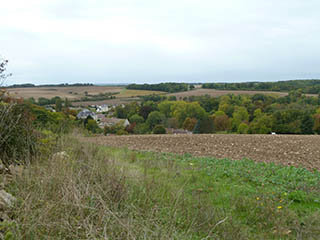Prochain point :
Château - ferme dimeresse - moulin - colombier
Prochain point : lat="49.136603" lon="2.145247"

A Valley Carved into the Plateau
Structuring the village
The name Labbeville is thought to be derived from the Latin abbatis villa (‘the house of the abbot’ or ‘abbey’), reminding us that the municipality once belonged to the abbeys of Saint Denis, Saint Martin de Pontoise and Conflans-Sainte Honorine. Although the area has been occupied by humans since prehistoric times, it was in the eleventh and twelfth centuries that the village really began to develop. A range of factors made the valleys attractive: the proximity of rivers and springs, protection from the wind and the availability of building materials (the outcrops are made from limestone). A string of villages took shape across the Sausseron valley, with Labbeville situated at the confluence of three valleys formed by the Frouville and Hédouville streams and the Sausseron. These valleys are surrounded by hills and a plateau where woods and cereal crops meet. The meadows and fields are sometimes delineated by hedgerows that play a key role in regulating storm water runoff (among other things).
The houses here were first organised around a nucleus consisting of the church, château and two large farms (Maigniel and Leroy). They subsequently grew towards the hamlets of Mesnil, Chantepie, La Bauve, Brécourt and Petit Biard. The dwellings are built without any gaps between them and give onto the street.
A wetland on the valley floor
The plateau rests on a thick layer of coarse Lutetian limestone (from 47.8 to 41.3 million years ago). The slopes of the valley cut into the limestone slab and underlying aquifer sands (called Cuise sands). In the valley, peaty alluvial covers an impermeable clay layer. The wet valley floor is due to the presence of a significant water reserve at the foot of the slopes that forms a large aquifer discharging into the Sausseron. The steep hillsides are covered in oak, hornbeam, maple and linden. At the bottom of the small valleys, afforestation (ash, willow and alder) is to be found alongside wet meadows. This diverse environment forms a precious reservoir of biodiversity that is home to many species of flora and fauna. It also plays a fundamental role in flood control and surface water purification.
A place of pilgrimage
A pilgrimage was long held every January 20 to this site overlooking the village: it was a sign of gratitude for the Labbevillois spared by the plague in 1668 following a procession to Notre-Dame de Pontoise. The statue of Notre Dame de la Délivrance, representing the Virgin, was erected in 1946 to commemorate the battles of the Liberation on August 30, 1944, during which an ammunition depot exploded in Labbeville without casualties.




